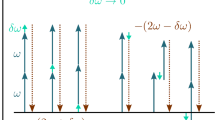Abstract
An ab initio computational investigation of the electric–field–gradient–induced birefringence in H2 and D2 is presented. The quadrupole moment and all linear and non-linear optical properties contributing to the induced anisotropy of the refractive index are computed by means of Coupled Cluster Singles and Doubles response theory. The latter leads for these systems to Full Configuration Interaction results. Vibrational averaging, centrifugal distortion due to rotation, isotope effects and differences between ortho and para species are also considered.
Similar content being viewed by others
References
Buckingham AD (1959). J Chem Phys 30:1580
Buckingham AD, Disch RL (1963). Proc Roy Soc A 273:275
Buckingham AD, Longuet-Higgins HC (1968). Mol Phys 14:63
Buckingham AD, Jamieson MJ (1971). Mol Phys 22:117
Imrie DA, Raab RE (1991). Mol Phys 74:833
Rizzo A, Coriani S, Halkier A, Hättig C (2000). J Chem Phys 113:3077
Coriani S, Halkier A, Jonsson D, Gauss J, Rizzo A, Christiansen O (2003). J Chem Phys 118:7329
Coriani S, Halkier A, Rizzo A, Ruud K (2000). Chem Phys Lett 326:269
Coriani S, Halkier A, Rizzo A (2001) In: Recent Res. Devel. Chem. Physics, vol. 2. Pandalai S(ed) Transworld Scientific, Trivandrum, Kerala, India pp 1–21
Raab RE, de Lange OL (2003). Mol Phys 101:3467
de Lange OL, Raab RE (2004). Mol Phys 102:125
Buckingham AD, Pariseau M (1966) . Trans Faraday Soc 62:1
Van Vleck, JH (1932) The theory of electric and magnetic susceptibilities, sect 3. Oxford University Press, Oxford
Olsen J, Jørgensen P (1995) In: Modern electronic structure theory, Part II. Yarkony DR(ed) World Scientific, Singapore
Coriani S, Hättig C, Jørgensen P, Rizzo A, Ruud K (1998). J Chem Phys 109:7176
Coriani S, Hättig C, Rizzo A (1999). J Chem Phys 111:7828
Huber KP, Herzberg GH (1979) Molecular spectra and molecular structure Constants of diatomic molecules. Van Nostrand-Reinhold, New York
Helgaker T, Jensen HJA, Jørgensen P, Olsen J, Ruud K, Ågren H, Bak KL, Bakken V, Christiansen O, Coriani S, Dahle P, Dalskov EK, Enevoldsen T, Fernández B, Hättig C, Hald K, Halkier A, Heiberg H, Hettema H, Jonsson D, Kirpekar S, Kobayashi R, Koch H, Mikkelsen KV, Norman P, Packer MJ, Pedersen TB, Ruden TA, Sánchez de Merás A, Saue T, Sauer SPA, Schimmelpfenning B, Sylvester-Hvid KO, Taylor PR, Vahtras O (2001) dalton, an ab initio electronic structure program, Release 1.2 See http://www.kjemi.uio.no/software/dalton/dalton.html
Dunning Jr TH (1989). J Chem Phys 90:1007
Kendall RA, Dunning Jr TH, Harrison RJ (1992). J Chem Phys 96:6796
Woon DE, Dunning Jr TH (1994) . J Chem Phys 100:2975
Andersson K, Blomberg MRA, Fülscher MP, Karlström G, Lindh R, Malmqvist PÅ, Olsen J, Roos BO, Sadlej AJ, Schütz M, Seijo L, Serrano-Andrés L, et al. (1997) MOLCAS version 4 Lund University, Sweden
Mathematica, v. 5.2, from Wolfram Research
Ritchie GLD (1997) In: Optical, electric and magnetic properties of molecules. Clary DC , Orr B(eds) Elsevier, Amsterdam
Bishop DM (1990). Rev Mod Phys 62:343
Bishop DM, Cybulski SM (1994). J Chem Phys 101:2180
Bishop DM, Pipin J, Cybulski SM (1991). Phys Rev A 43:4845
Bishop DM, Cybulski SM (1990). J Chem Phys 93:590
Bishop DM, Lam B (1987). Chem Phys Lett 134:283
Bishop DM, Lam B (1988). J Chem Phys 89:1571
Bishop DM, Lam B (1988). Mol Phys 65:679
Fernandez B, Coriani S, Rizzo A (1998). Chem Phys Lett 288:677
Cappelli C, Ekström U, Rizzo A, Coriani S (2004). J Comp Meth Sci Eng (JCMSE) 4:365
Cappelli C, Ekström U, Rizzo A, Coriani S (2005) In: Maroulis G (ed) Computational aspects of electric polarizability calculations: atoms, molecules and clusters. IOS Press, Amsterdam, p. 365, ISBN 1586034952
Buckingham AD, Disch RL, Dunmur DA (1968). J Am Chem Soc 90:3104
Stogryn DE, Stogryn AP (1966). Mol Phys 11:371
Kolos W, Wolniewicz L (1964). J Chem Phys 41:3674
Wolniewicz L (1966). J Chem Phys 45:515
Bridge NJ, Buckingham AD (1966). Proc Roy Soc (London) A 295:334
Author information
Authors and Affiliations
Corresponding author
Additional information
An erratum to this article is available at http://dx.doi.org/10.1007/s00214-007-0278-6.
Rights and permissions
About this article
Cite this article
Buckingham, A.D., Coriani, S. & Rizzo, A. Investigation of electric-field-gradient-induced birefringence in H2 and D2 . Theor Chem Account 117, 969–977 (2007). https://doi.org/10.1007/s00214-006-0217-y
Received:
Accepted:
Published:
Issue Date:
DOI: https://doi.org/10.1007/s00214-006-0217-y




